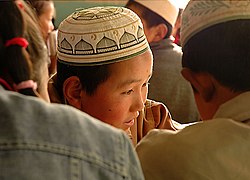Origin
Haplogroup analysis by Wen et. al. (2013) shows that the closest relative of Dongxiang people are the common ancestors of the Kyrgyz of Kyrgyzstan and Xinjiang, the Tajiks of Khujand, Tajikistan, and the Ishkashimis of Tajikistan. The second closest relative is the Salars of Xinhua, Qinghai. The third closest relative are the commons ancestors of the Uyghurs and Tajiks of Xinjiang, the Shughnis of Tajikistan, the Bartangi of Tajikistan and various Uzbeks of different Central Asian countries. [5]
STR analysis excluding Kyrgyz, Tajiks and other Central Asians might conclude Dongxiang is close to East Asians as a whole. [6]
Physical anthropological analysis by Li et. al. (2011) shows that the closest relative of Dongxiang men among the Chinese populations are the Tajiks in Tashkurgan, Xinjiang. The next closest relative is the common ancestor of the Mongols in Bayingolin, Xinjiang, the Salars in Xinhua, Qinghai and the Mongols in Tongliao, Inner Mongolia. The physical anthropology of Dongxiang women show her closest relative are the common ancestor of the Bonans in Jishishan, Gansu and the Oroqens in Oroqen Banner, Inner Mongolia. Her next closest relative is the common ancestors of the Monguors in Huzhu, Qinghai, the Salars in Xinhua, Qinghai and the Tajiks in Tashkurgan, Xinjiang. [7]
Distribution of Y-chromosome haplogroups in Dongxiang: [8]
O=24.29(O2=18.69,O1a=1.87,O1b=3.73)
J=16.82
R1=16.82(R1a=14.02,R1b=2.8)
R2=9.35
C=6.54
G=5.61
N=5.6
D=4.67
E=3.74
Others=6.56
In another study in 2010 found that the majority of the Dongxiang belonged to Haplogroup R1a (R1a : 54%). [9]
Intermarriage
The Dongxiang have Mongol, Han Chinese, Hui and Tibetan surnames. [10] Dongxiang with Han Chinese surnames such as Wang, Kang, Zhang, Gao and Huang claim descent from Han Chinese. Surnames such as Ma and Mu are of Hui origin. [11] [12]
Some Dongxiang have said that, in the rare instances that they do marry with other people, it is only with Han and Hui, but not Tibetans. [13]



